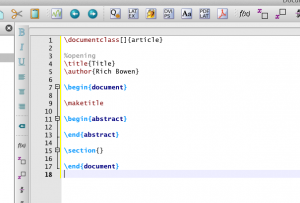 We’ve had a slow few weeks for podcasts, with everything else that’s been going on. But I have a new interview here with Tim Hoffmann of the the TeXstudio project.
We’ve had a slow few weeks for podcasts, with everything else that’s been going on. But I have a new interview here with Tim Hoffmann of the the TeXstudio project.
If you’d like to have your project featured on the SourceForge podcast, just drop me a note and we’ll schedule something.
If the embedded audio player below doesn’t work for you, you can download the audio in mp3 or ogg formats.
You can subscribe to this, and future podcasts, in iTunes or elsewhere, at http://feeds.feedburner.com/sourceforge/podcasts, and it’s also listed in the iTunes store.
Rich: I’m speaking with Tim Hoffmann, who is a member of the TeXstudio project. TeX is a typesetting language. It used to be used primarily for technical documentation. It was used a lot in mathematics, and since has expanded into many other realms. Tell me something about the project. What are you trying to accomplish with the project? How long have you been doing this?
Tim: I, myself, am a member of the project since about half a year ago. The project itself started I think in 2009. So, as you said, TeX or LaTeX is a typesetting language which is used mostly in science. Actually, it goes back to the 80s, already, when it was invented. And since then, it’s widely used. But because it’s so old, it has some issues which can – now, because we have today the computational power and the data available – which can be relieved by a good development environment. It’s actually the goal of TeXstudio is to make it more easy for the user to write documents in LaTeX.
Rich: What sort of functionality does it have toward that end?
Tim: Before I started contributing to TeXstudio itself, I tried a lot of other editors. They support the user to a certain extent, but I think most of them fall short in some way. For example, it’s a bit cumbersome to write tables in LaTeX. There are some editors which have an assistant, so you can create a new table, but once it’s there you cannot edit it via the assistant any more, but you have to go to the plain TeX. And so we thought, we have to support the user a bit more. For example, we have now functionality to edit the tables inline. Of course this means that we, to a certain extent, have to understand the language of TeX. So it’s not just the syntax, we analyze and highlight. By the way, I think TeXstudio is one of the editors with the most refined syntax highlighting system for TeX, which makes it much easier to read the document source code. But also we try – and this is still in its infancy – but we try to map the symantics of the commands, so we can really interpret what they mean – the commands to have a table, so we can assist the user if he wants to change something on the table.
Rich: Do you use TeX or LaTeX in your daily job? Is this a tool that you use actively for some projects of your own?
Tim: Yes. I am a physicist, and I regularly use TeX for papers and for my thesis.
Rich: To what extent is the TeXstudio community open to new contributors?
Tim: We’re very open to new contributors. You can contribute on various levels. So you don’t have to necessarily be able to program. You can contribute either by creating some documentation, or you can translate TeXstudio to a new language, or you can design icons if you want, or package TeXstudio for some other distribution. But of course, if you can program, you are very welcome also to contribute code.
Rich: What is planned for upcoming releases of this product? You talked about one set of functionality that’s under development. Is there anything else that we can expect in the future?
Tim: In the version control system we have quite a lot of new things which are not yet released. This includes a complete new build system. So, essentially, if you have a LaTeX document, you compile the source code to a final PDF, for example. This is a bit similar to compilation of some software. It can be a quite complicated process. TeXstudio can manage this for you. So you just press one button and you get the complete document out. Other things we have now is support for different tools of TeX. So, there’s a complete ecosystem of different TeX compilers and additional programs which handle bibliographies, and so on. We’ve recently implemented support for a lot of them. To go a bit more into the future, one aim we have is to make better project management. For example, you can have TeX documents – if you have a large document, like if you’re writing a book, it can be split into many different files, and we want to have a unified view for the user which is abstracted from the high level, but just shows the logic of the document. And of course, also we are trying to improve the user interface.
Rich: Thank you, Tim, for taking time to do this. And I wish you much success on your project.
Tim: Thank you very much. It was a pleasure talking to you.

